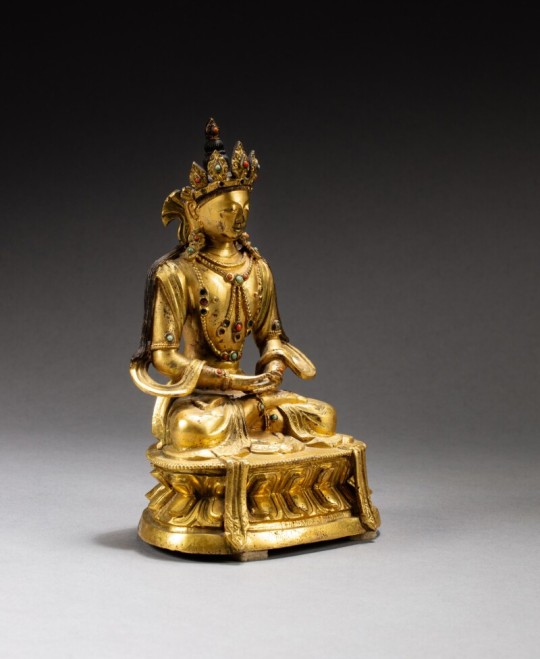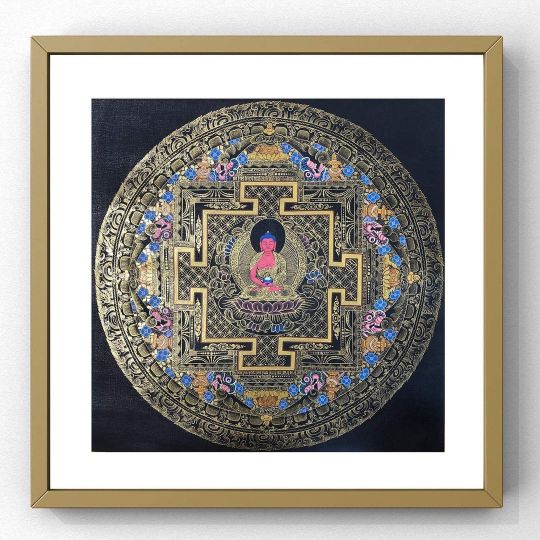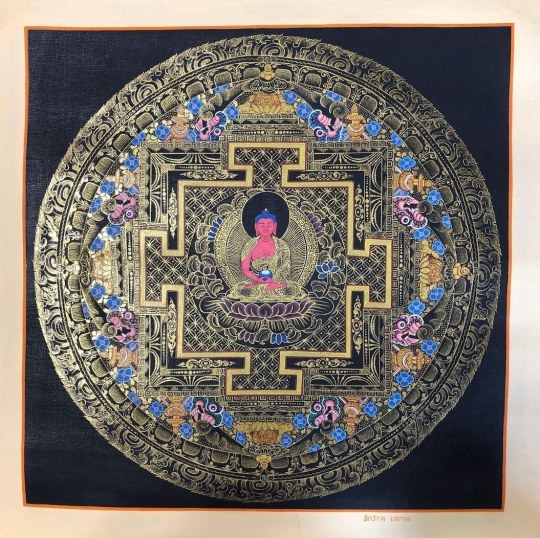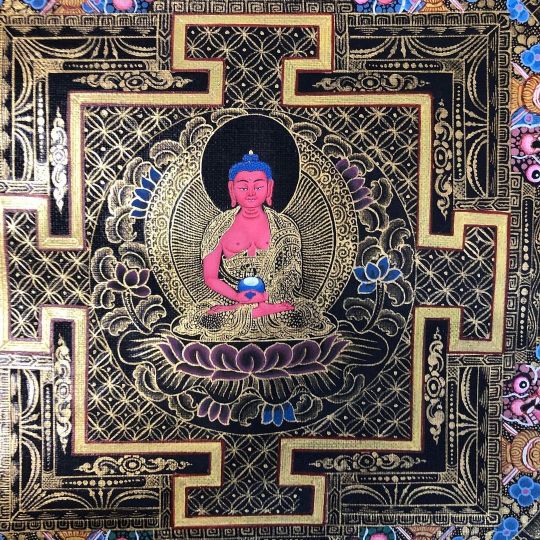#Amitayus
Photo

Amitayus Buddha
18-19th century, Qing Dynasty. China. Thangka (via Christie's)
57 notes
·
View notes
Photo






A gilt-bronze figure of Amitayus
Qing dynasty, 18th century
Seated in vajraparyankasana on a lotus base, the hands in dhyana mudra, embellished with turquoise inlays .
H. 17.3 cm, 6 3/4 in.
#A gilt-bronze figure of Amitayus#Qing dynasty 18th century#gilt-bronze#archeology#archeolgst#ancient artifacts#art#artist#art work#art world#art news#history#history news#ancient history#ancient culture#ancient civilizations
22 notes
·
View notes
Text


White Tara with Amityus and Ushnishavijaya
Talon Abraxas
48 notes
·
View notes
Text

Seated Amitayus
Mongolia 17th–18th century
The Buddha Amitayus holds a pot that contains the elixir of life; he is credited with providing devotees with health and longevity. Exemplifying the high artistic traditions of Zanabazar, Amitayus’ face reflects his perfect state of meditation. The gilding of this delicately rendered image is especially effective in conveying the light that radiates from Amitayus’ body as an expression of his enlightenment.
17 notes
·
View notes
Text

Kuan Yin
* * * *
“In the months and years following my participation in the completion of Oracle of Compassion: the Living Word of Kuan Yin, I did, in accordance with the deity’s former declaration—that she would continue sending important dreams, experience many dreams and visitations from Kuan Yin. It was after completing the transcription of some of the Kuan Yin quotes that I fell into a deep slumber. Just before awakening, I dreamt of Kuan Yin standing in my living room directly in front of the marble-tiled fireplace wherein Lena Lees and I would hold prayer circles.
So real was this vision that I could hear the deity’s sweet voice explain that there is a specific meditation for connecting with the Celestial Wisdom! Witnessing Kuan Yin lie face down on the Oriental Carpet with arms outstretched over Her head, I watched as Her thumb and forefinger formed a triangle—the dhyana mudra specifically designated to Kannon called the dhyana mudra displayed by the fourth Dhyani Buddha Amitabha, also known as Amitayus Kuan Yin. It was then that Kuan Yin further explained the significance of this specific mudra; that it acts similar to a capstone on an obelisk—drawing wisdom to one who has demonstrated intention to be a teacher of wisdom.
Aware that Kuan Yin was pointed in a northward direction, I surmised this particular alignment was also a significant aspect of the meditation—that this specific positioning was most ideal for receiving answers for prayers directed to the Her.
Later in the dream, it was confirmed that each person attracts from the universe, realities that are aligned with their specific beliefs and values.”
― Hope Bradford CHt, Kuan Yin Buddhism:: The Kuan Yin Parables, Visitations and Teachings
14 notes
·
View notes
Text

Amitabha is called Amitayus, or "Infinite Life." He is best known as the Buddha of Compassion.
Sometimes he is called the "Buddha of infinite merits" and also "Buddha of Infinite Light." His colour is red, his posture one of meditation (dhyana-mudra), his symbol the begging bowl.
#amitaba buddha#buddha#buddhist#buddhism#dharma#sangha#mahayana#zen#milarepa#tibetan buddhism#thich nhat hanh
12 notes
·
View notes
Text

RAINBOW GURU
In Rewalsar, known as Tso Pema in Tibetan, he secretly taught tantric teachings to princess Mandarava, the local king's daughter. The king found out and tried to burn him, but it is believed that when the smoke cleared he was found to be just sitting there, still alive and in meditation.Thus the king was greatly astonished by this miracle, the king offered Padmasambhava both his kingdom and Mandarava.
Padmasambhava then left with Mandarava, and took to Maratika Cave in Nepal to practice secret tantric consort rituals.
They had a vision of buddha Amitayus and achieved what is called the Rainbow body of the great transference in the Vajrayana tradition, a very rare type of spiritual realization.Practitioners of Padmasambhava's terma still achieve this type of realization today.Both Padmasambhava and Mandarava are still believed to be alive and active in this Rainbow Body form by their followers. She and Padmasambhava's other main consort, Yeshe Tsogyal who was responsible for hiding his numerous terma later in Tibet became fully enlightened.
.
.
.
.
.
#lamathankapaintingschool #bhaktapurdurbarsquare #buddhism #thangka #nepaleseart #thankaschool #gurupadmasambhava #rainbowguru #mandarava #Tantric #yeshetsogyal #himalayanart #rinpoche #thankapainting #sacred #heritage #livingheritage
19 notes
·
View notes
Photo


Amitayus Buddha Art | Traditional Buddhist Statue
Traditional Himalayan Art of Nepal
termatree.com
7 notes
·
View notes
Text

A finely embroidered silk fragment of Amitayus, Ming dynasty, 16th-17th century.
The fragment is finely embroidered in satin stitch with gold-couched outlines with Amitayus seated in dhyanasana on a green base with peach-colored lotus petals and holding the kalasa containing the Elixir of Life. His pale gold-colored body is adorned with yellow scarves encircling his arms and wearing a red and green dhoti, and behind him is a multi-colored aureole from which radiate foliate flames.
Courtesy Alain Truong
17 notes
·
View notes
Photo



Amitabha Buddha Mandala
Hasta Thangka Art Center wrote :
Amitabha Buddha is being portrayed as Shakyamuni Buddha but usually, he is often depicted seated in meditation mudra while earth touching mudra is reserved for a seated Shakyamuni Buddha alone. In Tibetan Buddhism, Amitabha is red in color (red being the color of love, compassion, and emotional energy). He is being known to protect beings from the negative emotions of attachment his unique emblem is the lotus.
He is thus associated with the attributes of the lotus: gentleness, openness, and purity. Amitabha is known as the red Buddha of the west and the most ancient among the Five Dhyani Buddhas of the Vajrayana tradition. Amitabha means infinite light and he is also known as “Amitayus” or Buddha of the infinite life. A mandala is a spiritual and ritual symbol in Asian cultures.
It can be understood in two different ways: externally as a visual representation of the universe or internally as a guide for several practices that take place in many Asian traditions, including meditation. In Hinduism and Buddhism, the belief is that by entering the mandala and proceeding towards its center, you are guided through the cosmic process of transforming the universe from one of suffering into one of joy and happiness.
Size =30cmx30cm, Price = 200$(Free shipping)
Material used = Cotton canvas, natural pigment, Real 24k gold
FB: Hasta Gola Mandala Thangka Art Center
(via Instagram: Hasta Thangka Art Center)
133 notes
·
View notes
Photo

Superb Buddhism Silver Gilt Gold Red Copper Amitayus Buddha Statue https://www.etsy.com/listing/1299383081/a4577-superb-buddhism-silver-gilt-gold?click_key=4b282926faf83e9e0c83282cb8df1481a0c7ab3a%3A1299383081&click_sum=db0437e3&ref=shop_home_feat_3&frs=1
3 notes
·
View notes
Note
Can I get some names for a GeorgeHD kin??
-sapnap 🔥💙🌻🌸
Sure thing! Here are the names!
Amanit
Aereus
Leccin
Morel
Amitayus
Devram
Keethan
Kimon
Morpheus
Eidniuet
I hope you like them :>
3 notes
·
View notes
Text
Mysore toMysore to Coorg Taxi Tours: Exciting Journey for Groups, Family and Couple Trips Coorg Taxi Tours: Exciting Journey for Groups, Family and Couple Trips

Have you ever traveled from the royal city of Mysore to the nature’s paradise Coorg? If you haven’t,you could book nowon mysoretocoorgtaxi.com for a great travel experience with a Mysore to Coorg Taxi ride.It is an amazing journey as you exploreCoorg’s scenic beauty and cultural heritage, which also happens to be the ‘Land of Coffee.’Going on family trips for sightseeing, couples on their honeymoon and even group trips with friends or colleagues is no longer a bother with the various car options we have on offer.
Journey to Coorg
An exciting journey begins with a Mysore to Coorg Taxi ride with family or friends as you drive through the picturesque locales. It is a pleasant 120 km trip as you take in the view of mountaintops and hidden waterfalls in the lush greeneryof the countryside. The winding roads take you on a beautiful journey as you pass coffee plantations and arecanut trees to your destination in a couple of hours.
Convenience with taxi trips
When you get to pick a car of your choice at affordable prices for an exciting trip, it’s a match made in heaven. Book online with the standard or customized packages to enjoy the privacy and comfort of an enjoyable family or group trip with Mysore to Coorg Taxi services. With no hidden costs and hassle-free payment modes, you can ride a well-maintained carequipped with other amenities such as AC, mobile chargers, water bottles etc.,as part of cab packages.
Places to see
Abbey falls
It is one of the most impressive waterfalls, at a height of 70 feet, nestled amidst spice and coffee plantations, especially during the monsoons. Abbey Falls gets a lot of visitors throughout the year to enjoy the serene beauty of nature. The place also has several spots for picnics and hiking.
Talakaveri
The Kaveri River originates from Coorg’s Talakaveri,whose source is visible in the monsoons.A small enclosed water spring flows undergroundto a small tank used for bathing. Apart from tourists, people visit Talkaveri for religious purposes.Inside the premises of the Talakaveri are two temples dedicated to Lord Shiva and Lord Ganesh.
Raja Seat
It’s a great place to view the scenic beauty of Coorg, as you could check out the sunrise and sunset from a vantage point here. Surrounded by greenery, the place houses a Gandhi Mantap, a play area for children, and a toy train ride through Raja Seat.
Namdroling monastery
Visiting the beautiful Namdroling monastery on the hilltop, also known as the golden temple of Kushalanagar, is one of the highlights of taking Mysore to Coorg Taxitrip. It houses 16000 refugees and 600 monks inside the temple complex. In the center of the temple, you will findthe statues of Lord Buddha, Lord Amitayus and Lord Padmasambhava on either side.
White river rafting at Barapole River
The BarapoleRiver is also known as the Kithu Kakathu River with natural surroundings. It's a great place of fun for adventure enthusiaststo rapid-raft on the 4kmriver stretch through Brahamagiri Wildlife Sanctuary.Travelers can seek their thrill with this one-of-a-kind experience.
Takeaway
Taking atrip to Coorg, from Mysore, away from the hustle and bustle of the city, is agreat outdoor experience.Hiring a reliable Mysore to Coorg Taxiservice with professional drivers doubling up as local guides can provide an insightful journey. Checking out the local food and history of the place is one of the best moments of going on a group trip.It isa great place for families, honeymooners and friends to spend quality time together and enjoy nature’s deligh

1 note
·
View note
Text
Taming the Monkey Mind - A Guide to Pure Land Practice


Taming the Monkey Mind - A Guide to Pure Land Practice
Taming the Monkey Mind - A Guide to Pure Land Practice. Pure Land Buddhism is branch of Mahayana Buddhism. In Pure Land practice people focus on buddha in the form of Amitabha, the buddha of infinite life and infinite light. Believers put their faith in Amitabha Buddha and recite his name, confident in the promises he has given to deliver all who invoke his name. Download the free ebook here: (145 pages) :

Taming the Monkey Mind
What is Pure Land Buddhism?
Pure Land Buddhism is a branch of Mahayana Buddhism that emphasizes devotion to the Buddha Amitabha (also known as Amitayus or Amida Buddha) as the primary means of salvation. The ultimate goal for Pure Land Buddhists is rebirth in the "Pure Land" or "Western Paradise" — a celestial realm where one can practice the Dharma without the distractions and difficulties present in our current world, thus ensuring progress toward enlightenment. Key features of Pure Land Buddhism include:
1. Nianfo/Nembutsu: The core practice of Pure Land Buddhism is the recitation of the name of Amitabha Buddha. In Chinese, it's called "nianfo" and in Japanese, it's "nembutsu." The most common form of this recitation is the phrase "Namo Amituofo" in Chinese or "Nam(u) Amida Butsu" in Japanese.
2. Faith and Devotion: Pure Land places a significant emphasis on sincere faith in Amitabha Buddha and his vow to save all sentient beings. By reciting his name with genuine faith, believers hope to be reborn in the Pure Land.
3. Amitabha's Vows: Central to Pure Land teachings are the 48 vows made by Amitabha Buddha, particularly the 18th vow, in which he promises to ensure the rebirth in his pure land of anyone who sincerely recites his name.
4. Pure Land: This is a paradisiacal realm described in various sutras where practitioners are free from rebirth in the six realms of samsara and can pursue enlightenment without the obstacles found in our current world.
5. Scriptures: Pure Land Buddhism relies on several sutras, but the most important are the Longer Sukhavativyuha Sutra, the Shorter Sukhavativyuha Sutra, and the Amitayurdhyana Sutra. These texts describe Amitabha Buddha, his vows, and the nature of the Pure Land.
6. Accessibility: One of the appeals of Pure Land Buddhism is its accessibility. The primary practice of chanting Amitabha's name is simple and can be done by anyone, regardless of their level of education, social status, or previous deeds.
Historically, Pure Land traditions became especially popular in East Asia, including countries like China, Japan, Korea, and Vietnam. In Japan, the Jodo Shinshu (True Pure Land School) and Jodo Shu (Pure Land School) are major representatives of this tradition. While the practices and teachings might differ slightly between regions and specific sects, the emphasis on faith in Amitabha and the aspiration to be reborn in the Pure Land remain central to all.
Read the full article
0 notes
Text

AMITAYUS YABYUM
Radiant deity of long life and vital practice in yabyum (nondual union) form.
#amitaba buddha#buddha#buddhist#buddhism#dharma#sangha#mahayana#zen#milarepa#tibetan buddhism#thich nhat hanh
4 notes
·
View notes